为进一步确定白垩纪陆相地层时代(Li Jianguo et al.,2004,2010,2011;Zhang Mingzhen et al.,2014,2015)、充分认识白垩纪温室气候特征(Li Jianguo et al.,2010;Du Baoxia et al.,2014;Dai Jing et al.,2017),近年来关于白垩纪孢粉学研究取得了显著进展。因白垩纪陆相地层分布广泛,我国白垩纪陆生孢粉学研究相对深入(Li Jianguo et al.,2004,2010,2011;Zhang Mingzhen et al.,2014,2015;Du Baoxia et al.,2014;Dai Jing et al.,2017)。白垩纪时期,我国南北气候具有分布差异大,沉积条件不同等特征导致北方沉积区的孢粉化石保存相对完好,这也进一步导致我国北方地区孢粉学研究相对优于南方区域(Li Hanshi et al.,2014;Wang Liyan et al.,2014;黄猛等,2019;杜圣贤等,2019)。特别是在红色陆相碎屑沉积广泛分布,生物化石材料匮乏的南方地区,孢粉学研究相对滞后。
四川盆地广泛分布白垩系沉积,并以红色陆相碎屑沉积为典型特征,特别是四川盆地北部红色沉积层分布最为广泛(简称川北红层)。扬子地台周缘孢粉学研究成果突出(梁定益等,1982;李鼎容等,1987;张仁杰等,2000;万德芳,2002;卢远征等,2005;王涛等,2006;许哲平等,2009;Yang Zhenjing et al.,2014;苗慧心等,2018)。受矿产资源匮乏、沉积环境影响等原因,盆地白垩纪沉积中化石少见,前人仅发现了介形虫类(施从广等,1963;王孟筠等,1982)、零星的叶肢介类(沈炎彬等,1982)和微咸水有孔虫(李玉文,1979;李素萍等,2016)。尽管化石材料匮乏,但为初步确定盆地沉积地层的地质时代起了关键作用。根据盆地内白垩纪地层具有沉积厚度大、高角度等特点,江新胜等(2006)推测沉积环境为沙漠沉积。但一直以来由于缺乏相关植物化石资料,特别是花粉组合丰富的孢粉化石,极大的制约了关于这套地层的相对精确地质时代以及古环境背景的准确认识。
2015年,笔者在四川盆地北部苍溪县木门地区开展铀矿地质调查钻探查证过程中,在川北木门地区地层中发现了早白垩世孢粉化石Dicheiropollis、Classopollis及其他孢粉类型,并进行孢粉取样分析研究。通过对苍溪组—白龙组的孢粉开展地层时代、早白垩世古植被特征以及其古气候特征研究,以期为四川盆地早白垩世孢粉地层对比提供最新参考依据,为邻区早白垩世生物地层对比、古植被重建以及古气候分析提供新的孢粉学证据,也为研究四川盆地北部早白垩世植被演化奠定基础。
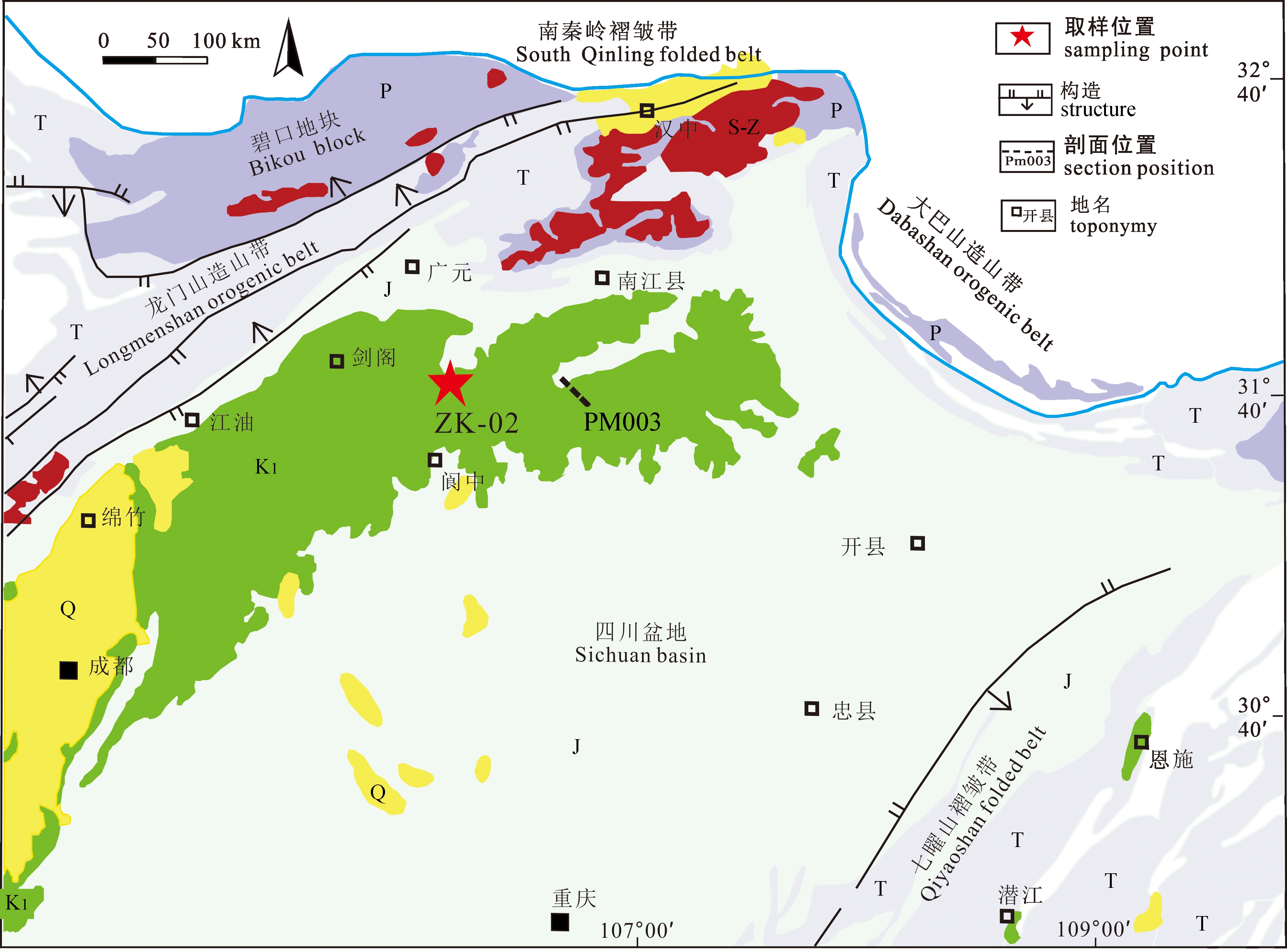
图1 四川盆地北部地质简图及研究区位置
Fig. 1 The sketch geological map of northern Sichuan Basin and location of the research area
Q—第四系; K1—下白垩统;J—侏罗系; T—三叠系; P—二叠系; Z—S—震旦系—志留系
Q—Quaternary; K1—Lower Cretaceous;J—Jurassic; T—Triassic; P—Permian\; Z—S—Sinian(Ediacaran)—Silurian
1 地质背景
四川盆地位于中国西南地区(图1),充填了巨厚早古生代至新生代沉积物。西侧松潘—甘孜褶皱带和龙门山冲断带、北侧秦岭造山带和米仓山—大巴山冲断带、东南侧雪峰山冲断带等几条大型构造带控制了盆地规模和形状。在秦岭造山带与扬子地块碰撞过程中,四川盆地成为大型内陆坳陷盆地(Wang Erchie et al., 2009;张岳桥等,2011)。
早白垩世时期,盆地沉积区域开始萎缩,沉积中心主要分布在龙门山断裂带前缘。白垩系早期地层沉积最厚地区主要位于川北广元以及巴中一带,赵亚曾(1931)将之命名为城墙岩群,以一套多韵律的红色厚层细砂岩为主要特征。此外,王孟筠等(1982)将其从下向上划分为苍溪组、白龙组、七曲寺组及古店组。城墙岩群沉积具有粗—细韵律,沉积特征变化小等特点。
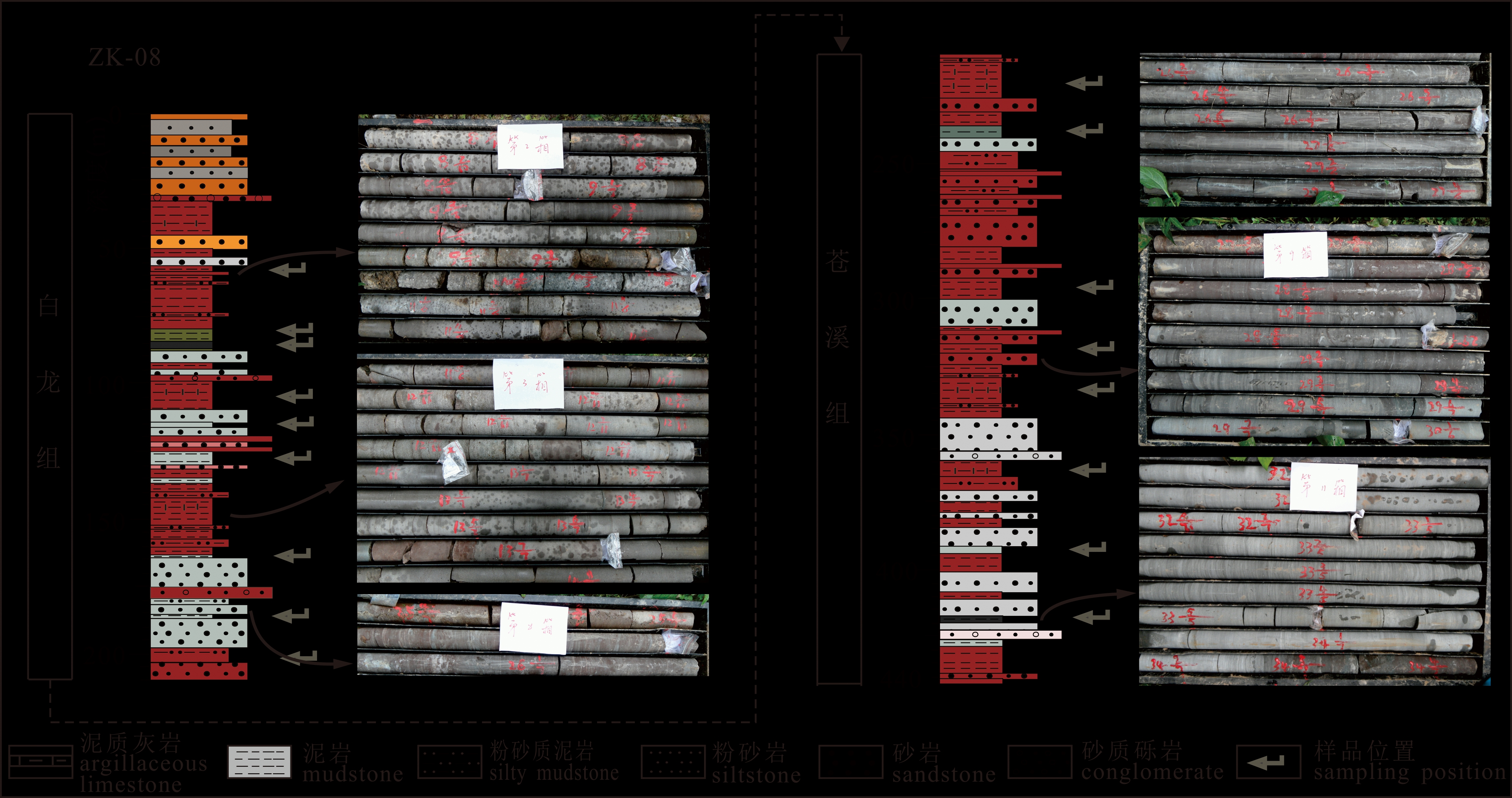
图2 四川苍溪地区ZK-08钻孔柱状图、孢粉样位置及编号
Fig. 2 Drilling columnar map of the Drill ZK-08 in Cangxi area, palynological sample locations and their serial numbers
四川盆地白垩纪沉积物主色调为红色,反映了氧化环境(Quan Cheng et al., 2015),不利于孢粉、植物、藻类等有机质化石的保存。20世纪60年代至80年代,该地层内陆续发现了一些钙质微生物化石(施从文等,1963;李玉文,1979;王孟筠等,1982;沈炎彬等,1982),研究人员根据介形类化石的类型,将城墙岩群确定为早白垩世(施从文等,1963;王孟筠等,1982)。黎文本(1983)、Li Jianguo等(2010)根据研究成果,将白垩纪中国区域划分为四大古植物地理区域。根据划分界线,四川盆地处于华南地区Classopollis—Schizaeoisporites孢粉植物群省(黎文本,1983;Li Jianguo et al., 2010),古气候以干燥气候环境为特征。
2 样品采集和处理方法
本次研究所有孢粉样品均采自旺苍县北部的ZK-08钻孔(图2)及剖面PM003(图3),钻孔钻穿苍溪组与白龙组,两套地层以厚层砂岩进行区分。
苍溪组内识别出4个粗—细沉积旋回,在红色泥岩中发育薄层绿色、深灰绿色泥岩夹层。钻孔揭露地层厚度大约440 m,共采集到87个样品,主要为灰绿色、灰黑色及红色泥岩,剖面编号为PM003,位于巴中市正直镇,剖面长度960 m,控制地层为上侏罗统蓬莱镇组、下白垩统苍溪组,控制地层厚度约270 m,共采集样品2个,岩性主要为灰绿色、深灰色泥岩和粉砂质泥岩。
孢粉样品的制备及鉴定在中国科学院西北生态环境与资源研究所石油资源研究重点实验室完成。首先采用常规酸、碱处理进行分离(盐酸去除碳酸盐矿物、氢氟酸去除硅酸盐矿物);其次,通过重液法将有机质与黏土矿物离心分离,对可能产生孢粉的残余物,进行10 μm尼龙筛过滤,取残基进行分析。本次选用宋之琛等(1999,2000)的《中国孢粉化石》及高瑞祺(1999)的《松辽盆地白垩纪石油地层孢粉学》孢粉鉴定标准作为鉴定依据,对孢粉样本进行形态、丰度和多样性统计分析。
3 苍溪组—白龙组孢粉组合
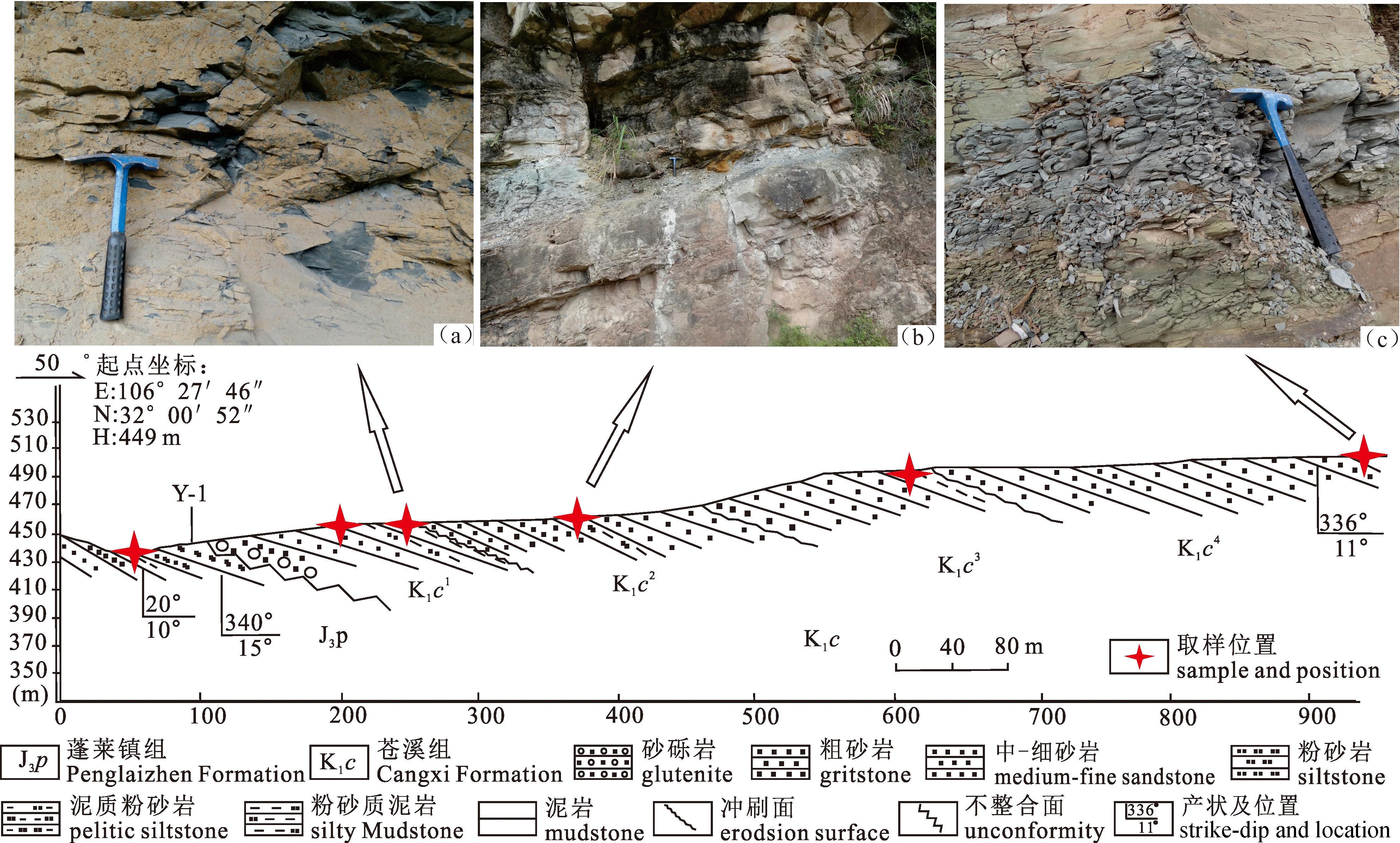
图3 四川苍溪县正直镇苍溪组PM003剖面图及孢粉样取样位置
Fig. 3 The Section PM003 map of the Cangxi Formation and palynological sampling locations in Zhengzhi Town, Cangxi County
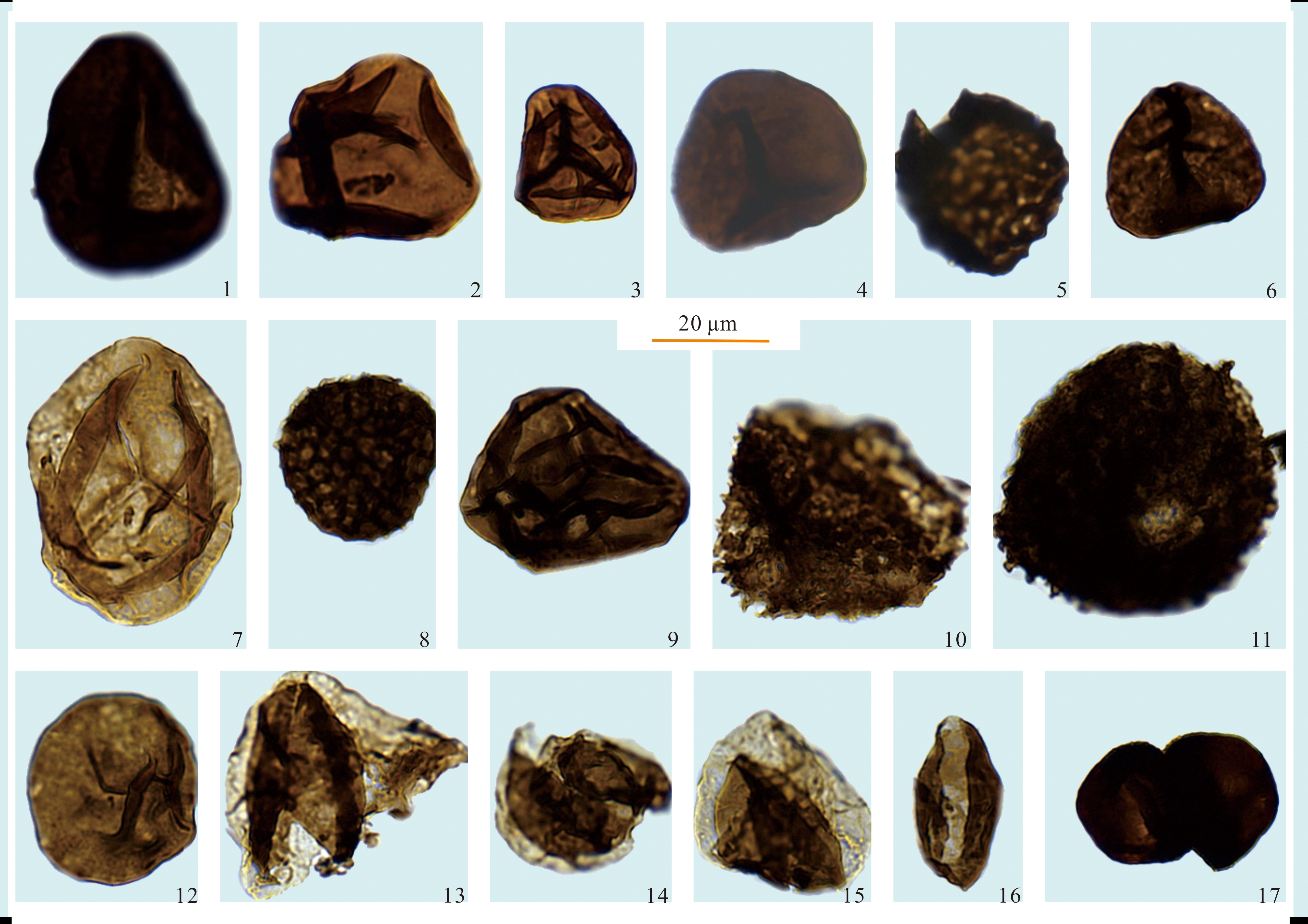
图4 四川盆地北部苍溪组、白龙组主要花粉及孢子类型(ZK-08及PM003)
Fig. 4 Main pollen and spore types in the Cangxi Formation and the Bailong Formation (the Drill ZK-08 and the Section PM003) in northern Sichuan Basin
1—小桫椤孢;2—南美杉粉属未定种;3、7、9—芦木孢属未定种;4—波缝孢未定种;5、8—石松孢属未定种;6、10~11—刺毛孢属未定种;12、13~15—同心粉属未定种;16—整洁苏铁粉;17—伊特拉斯双手粉
1—Cyathidites minor;2—Araucariacites sp.;3, 7,9—Calamospora sp.;4—Undulatisporites sp.;5, 8—Lycopodiumsporites sp.;6, 10~11—Pilosisporites sp.;12, 13~15—Concentrisporites sp.;16—Cycadopites nitidus;17—Dicheiropollis etruscus
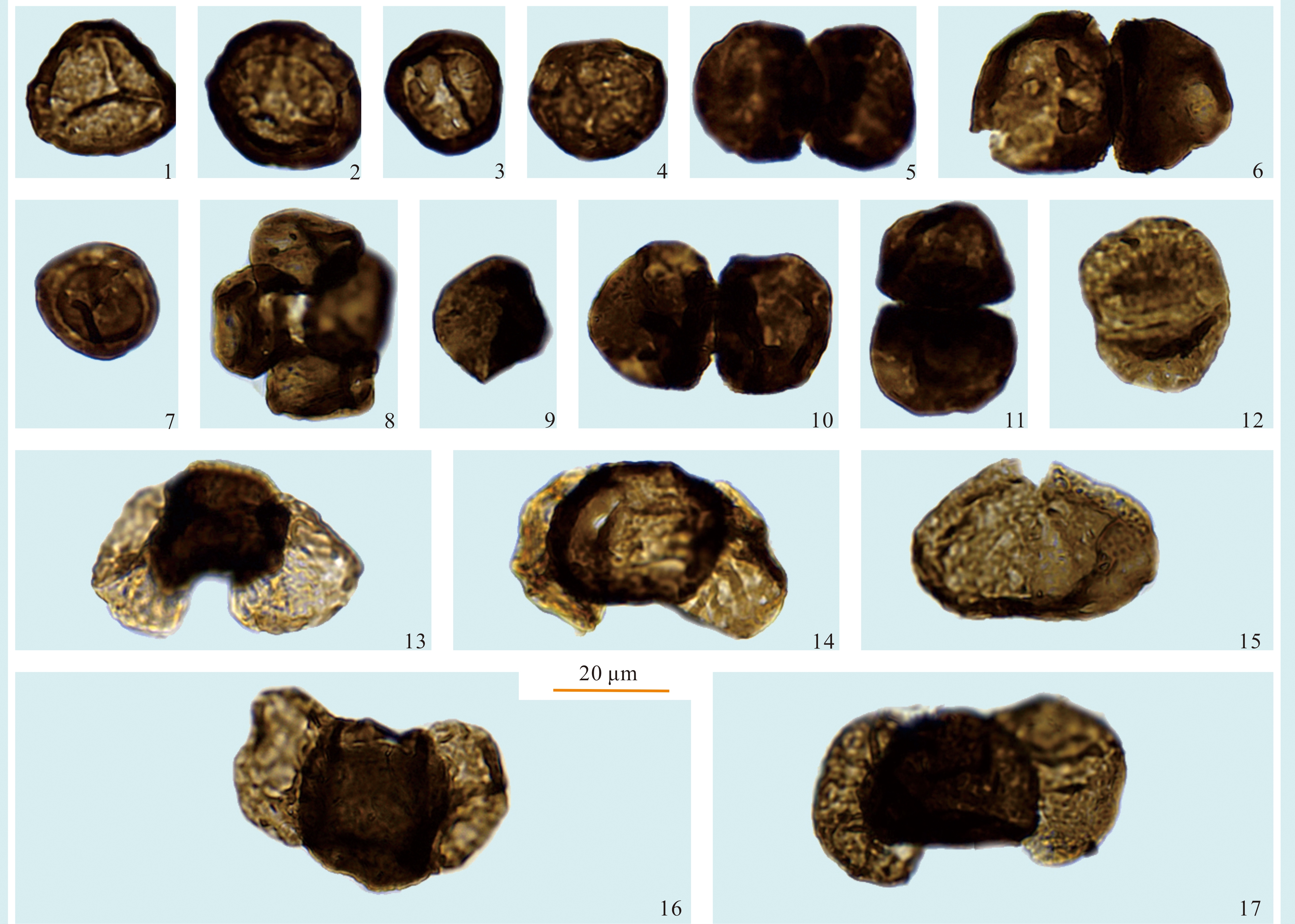
图5 四川盆地北部苍溪组、白龙组主要花粉及孢子类型(ZK-08及PM003)
Fig. 5 Main pollen and spore types in the Cangxi Formation and the Bailong Formation (the Drill ZK-08 and the Section PM003) in northern Sichuan Basin
1~4、7~8—环圈克拉索粉;5~6、10~11—伊特拉斯双手粉;9—三角孢属未定种;12—原始松柏粉属未定种;13~14、16~17—罗汉松粉属未定种;15—小古松柏粉
1~4, 7~8—Classopollis annulatus;5~6, 10~11—Dicheiropollis etruscus;9—Deltoidospora sp.;12—Protoconiferus sp.;13~14, 16~17—Podocarpidites sp.;15—Paleoconiferus minor
在苍溪组—白龙组样品中,孢粉化石丰度及多样性相对较差,仅从正直镇PM003苍溪组剖面2个样品及ZK-08钻孔17个样品中分离出21个孢子类型和25个花粉类型(图4、图5),这些化石都保存在灰绿色和红色的泥岩夹层中。孢粉颜色从橙色到棕色不等,碳化作用明显,化石表面形态破坏相对严重。孢粉组合以裸子植物花粉为主(表1),其次是蕨类孢子,未见被子植物花粉。Classopollis花粉占主要地位,平均含量82.0%,但样品最高达93.8%,除了Classopollis, 双气囊型松柏类花粉 (主要包括Palaeoconiferus、Piceites, Pinuspollenites, Podocarpidites, Protoconiferous和Protopinus等)含量变化在1.1%和13.4%之间,平均为6.2%。其他花粉类群,如Perinopollenites, Callialasporites, Exesipollenites, Chasmatosporites, Cycadopite, Dicheiropollis等含量不到总和的1%。上述孢粉的丰度和多样性相对较低,孢子组合以Cyathidites(平均0.8%)和Deltoidospora(平均1.8%)为主,其次为Osmundacidites(平均0.8%)。其他孢子类型,如Cicatricosisporites, Baculatisporites, Ceratosporites, Leptolepidites, Interulobites, Neoraistrickia, Lygodiumsporites, Lycopodiumsporites及Cooksonites均非常罕见。
4 讨论
4.1 苍溪组—白龙组孢粉地层时代
根据地层对比结果,苍溪组—白龙组最初被归属于晚侏罗世,与上侏罗统蓬莱镇组混淆(王孟筠,1982)。直到20世纪60年代至80年代发现了一些钙质微体化石,特别是介形虫,才将苍溪组—白龙组时代确定为早白垩世(施从文等,1963;王孟筠,1982;沈炎彬等,1982)。但是,近30年来由于孢粉化石的发现较少,关于四川盆地苍溪组—白龙组年代地层研究基本没有取得任何进展。本次研究,ZK-08中发现的孢粉化石为苍溪组—白龙组地层年代的确定提供了重要证据。
表1 苍溪地区钻孔ZK-08及剖面PM003样品孢粉化石统计表
Table 1 Spore and pollen abundance statistics of the Drill ZK-08 and the Section PM003 in Cangxi area, northern Sichuan Basin
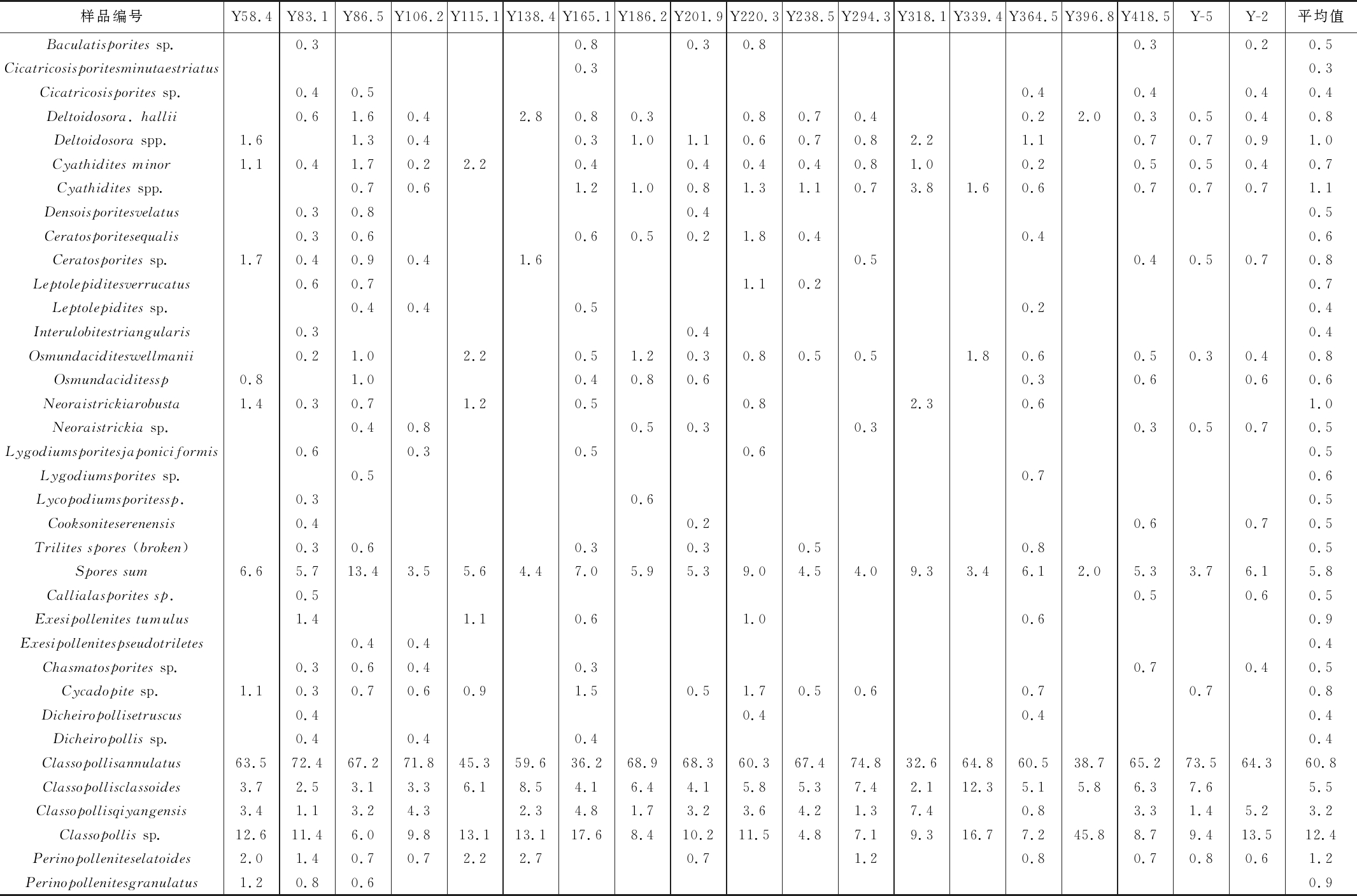
样品编号Y58.4Y83.1Y86.5Y106.2Y115.1Y138.4Y165.1Y186.2Y201.9Y220.3Y238.5Y294.3Y318.1Y339.4Y364.5Y396.8Y418.5Y-5Y-2平均值Baculatisporites sp.0.30.80.30.80.30.20.5Cicatricosisporitesminutaestriatus0.30.3Cicatricosisporites sp.0.40.50.40.40.40.4Deltoidosora. hallii0.61.60.42.80.80.30.80.70.40.22.00.30.50.40.8Deltoidosora spp.1.61.30.40.31.01.10.60.70.82.21.10.70.70.91.0Cyathidites minor1.10.41.70.22.20.40.40.40.40.81.00.20.50.50.40.7Cyathidites spp.0.70.61.21.00.81.31.10.73.81.60.60.70.70.71.1Densoisporitesvelatus0.30.80.40.5Ceratosporitesequalis0.30.60.60.50.21.80.40.40.6Ceratosporites sp.1.70.40.90.41.60.50.40.50.70.8Leptolepiditesverrucatus0.60.71.10.20.7Leptolepidites sp.0.40.40.50.20.4Interulobitestriangularis0.30.40.4Osmundaciditeswellmanii0.21.02.20.51.20.30.80.50.51.80.60.50.30.40.8Osmundaciditessp0.81.00.40.80.60.30.60.60.6Neoraistrickiarobusta1.40.30.71.20.50.82.30.61.0Neoraistrickia sp.0.40.80.50.30.30.30.50.70.5Lygodiumsporitesjaponiciformis0.60.30.50.60.5Lygodiumsporites sp.0.50.70.6Lycopodiumsporitessp.0.30.60.5Cooksoniteserenensis0.40.20.60.70.5Trilites spores (broken)0.30.60.30.30.50.80.5Spores sum6.65.713.43.55.64.47.05.95.39.04.54.09.33.46.12.05.33.76.15.8Callialasporites sp.0.50.50.60.5Exesipollenites tumulus1.41.10.61.00.60.9Exesipollenitespseudotriletes0.40.40.4Chasmatosporites sp.0.30.60.40.30.70.40.5Cycadopite sp.1.10.30.70.60.91.50.51.70.50.60.70.70.8Dicheiropollisetruscus0.40.40.40.4Dicheiropollis sp.0.40.40.40.4Classopollisannulatus63.572.467.271.845.359.636.268.968.360.367.474.832.664.860.538.765.273.564.360.8Classopollisclassoides3.72.53.13.36.18.54.16.44.15.85.37.42.112.35.15.86.37.65.5Classopollisqiyangensis3.41.13.24.32.34.81.73.23.64.21.37.40.83.31.45.23.2Classopollis sp.12.611.46.09.813.113.117.68.410.211.54.87.19.316.77.245.88.79.413.512.4Perinopolleniteselatoides2.01.40.70.72.22.70.71.20.80.70.80.61.2Perinopollenitesgranulatus1.20.80.60.9

苍溪组—白龙组的显著特征是Classopollis所占比例高,这类花粉具有较长的演化历史,时代从三叠纪晚期到白垩纪晚期,特别是在晚侏罗世(Zhang Mingzhen et al., 2014)和早白垩世时期会(周山富等,2009)出现两个明显的峰值,常以Classopollis伴生孢子组合的特征来区分两个峰值的地质时间阶段。与晚侏罗世相比,早白垩世的Cyathidites, Deltoidospora, Osmundacidites, Cicatricosisporites, Ceratosporites, Leptolepidites, Interulobites, Neoraistrickia, Lygodiumsporites, Lycopodiumsporites以及Cooksonites等更具多样化。本研究中苍溪组—白龙组的孢子组合类型丰富,明显与早白垩世孢子组合特征一致。
此外,Cicatricosisporites也为白垩纪地层时代的确定提供了依据,它在早白垩纪地层中零星出现,并从中白垩世开始迅速多样化和增加(高瑞祺,1999;Ied and Lashin, 2016)。本次研究发现,苍溪组—白龙组中Cicatricosisporites分化为两种,类型相对单一,该特征指示产出地层可能属于早白垩世早期。Interulobitestriangularis在下白垩统较为常见,如中国东北阜新组(高瑞祺等,1999),内蒙古二连盆地赛汉塔拉组(花如洪,1991),哥伦比亚的巴塔组(Serna et al., 2003),以及阿根廷东北火地岛组(Quattrocchio et al., 2006)。根据以上研究成果,苍溪组—白龙组的时代应被限定在早白垩世。
苍溪组—白龙组Dicheiropollis地层意义更加明显,该分子主要分布在低纬度特提斯洋沿岸地区,由于其地质时间跨度短,常被作为确定时代的典型地层指示化石。国内在云南省富民盆地的安宁组(张望平,1995)、西藏高原北部的索瓦组和雪山组(Li Jianguo et al., 2004;陈文斌等,2012)以及塔里木盆地的舒善河组(李玉文,1979)中均发现了Dicheiropollis。通过使用有孔虫和甲藻的记录进行年代校准(Racey et al., 2009; Li Jianguo et al., 2011),确定含Dicheiropollis的地层时代跨度为Valanginian晚期到Barremian早期。
前人通过沉积序列建立了两个Dicheiropollis带(Li Jianguo et al., 2004),与上部区域不同,下部的Dicheiropollis区具有化石丰度低,跨越时间短的特征,且可以与苍溪组—白龙组进行对比。此外,Ephedripites是早白垩纪晚期和白垩纪中期最常见的花粉类型(高瑞祺等,1999;Zhang Mingzhen et al., 2015),但本次岩芯样本中并未发现该花粉类型。因此,此次研究初步将苍溪组—白龙组的地层时代划分为Valanginian到Hauterivian期。
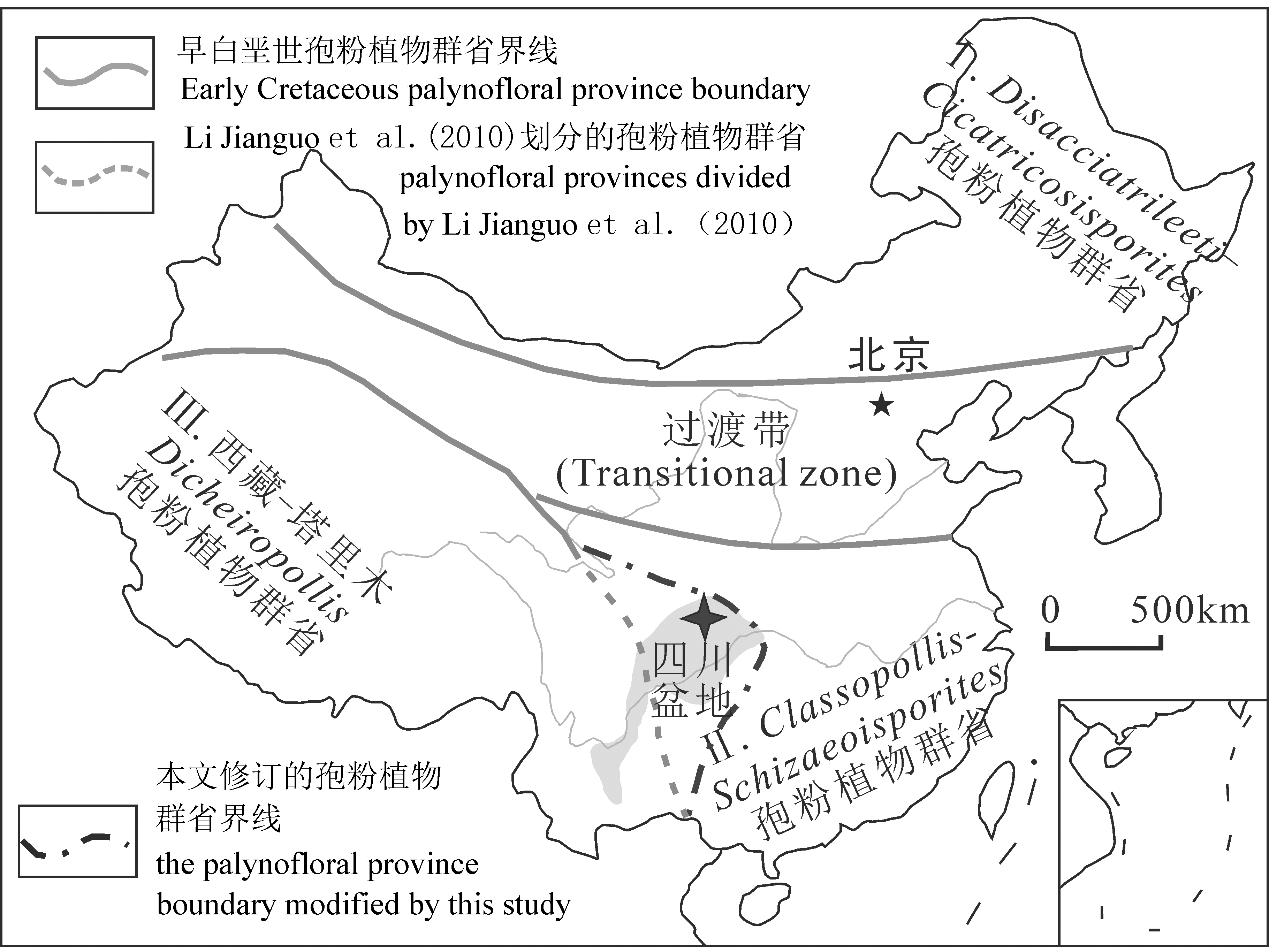
图6 早白垩世我国植物孢粉群省分区图
Fig. 6 The distribution of Early Cretaceous playnoflora province in China
4.2 古环境及古地理意义
4.2.1 古植被及古地理重建
根据主要孢粉型的亲缘关系(Zhang Mingzhen et al., 2014),识别早白垩世苍溪组—白龙组的植物亲缘关系。首先,Classopollis占主导地位,表明相对单一的植被以掌鳞杉科(Cheirolepidiaceae)为主(图4),Dicheiropollis虽然含量低,但也是来自于掌鳞杉科。其次,松柏类花粉(图4),如云杉Piceaepollenites,松属Pinuspollenites、罗汉松Podocarpidites和杉科(Perinopollenites)也很常见。一些双气囊未发育的花粉,如Protoconiferous, Palaeoconiferus, Rugubivesiculites, Protopinus及Piceites花粉,很可能也是来自于松柏科。蕨类植物孢子含量低,表明其可能在植物群落中占从属地位。桫椤科或蚌壳蕨科(Cyathidites、Deltoidosora)是蕨类植物中最丰富的代表,最后是紫萁科(Osmundacidites)和一些石松类(Lygodiumsporites, Neoraistrickia, Leptolepidites等)。苍溪组—白龙组的孢粉植物群指示出由掌鳞杉科(Cheirolepidiaceae)为主的单一型森林群落特征,底部分布少量矮生植被。
四川盆地早白垩世植被类型与古特提斯沿岸的其他地区非常相似。掌鳞杉科(Cheirolepidiaceae)产生的花粉(Classopollis和Dicheiropollis)占主导地位,并且其花粉占孢粉总量的70%~90%。如云南省富民盆地(张望平,1995),青藏高原北部(Li Jianguo et al., 2004; 陈文斌等,2012),青海中部—西藏高原(Lin Miaoqin et al., 2018)和西北地区塔里木盆地(黎文本,2000),蕨类植物孢子及针叶树花粉占比较低。这表明早白垩世时期,四川盆地北部一带是以掌鳞杉科(Cheirolepidiaceae)为主的单一植被类型。此外,在中国东部及东南部地区,掌鳞杉科(Cheirolepidiaceae)Classopollis花粉含量较高,在孢粉中占主导地位(郑芬等,1986;王开发等,1989)。麻黄属(Ephedra)和隐孔粉属(Exesipollenites)花粉在中国东部及东南部地区相对丰富,但它们在特提斯海毗邻地区通常非常罕见。
在中国东部和东南部没有观察到由掌鳞杉科(Cheirolepidiaceae)产生的Dicheiropollis。在亲缘关系方面,Dicheiropollis和Classopollis都属于掌鳞杉科(Cheirolepidiaceae)产生的花粉,因此可能具有密切关系。除了本次研究的四川盆地外,古特提斯海北部的广阔区域,从泰国到我国西北地区塔里木盆地,均表现出以掌鳞杉科(Cheirolepidiaceae)为主的植被。沿着古特提斯洋可识别不同植物区,并被命名为西藏—塔里木Dicheiropollis孢粉植物群省(黎文本,1983;Li Jianaguo,2010)(图6)。最后,研究发现四川盆地的Dicheiropollis含量远低于西藏北部和中部的腹地(Li Jianguo et al.,2004;陈文斌等,2012;Lin Miaoqin et al.,2018),塔里木盆地属于西藏—塔里木Dicheiropollis孢粉植物群省(黎文本, 2000)。在四川盆地东部或北部地区没有发现Dicheiropollis花粉记录。因此,笔者等认为研究区位于西藏—塔里木Dicheiropollis孢粉植物群省的东部边界附近。
从云南的富民盆地到新疆的塔里木盆地,这两个植物地理省的边界横跨3000 km,目前还没有任何数据点来界定。在以往的研究中,四川盆地被划分为中国东南部的Classopollis—Schizaeoisporites孢粉植物群省(图6)(黎文本,1983;Li Jianguo et al.,2010)。根据本次研究结果,笔者建议将四川盆地归为西藏—塔里木Dicheiropollis孢粉植物群省(图6),中国东南部Classopollis—Schizaeoisporites孢粉植物群省与西藏—塔里木Dicheiropollis孢粉植物群省的界线至少移动到四川盆地东部。这表明古特提斯洋沿岸植物地理分布可能比早期研究中提出的区域更宽。
4.2.2 古气候
四川盆地下白垩统地层以厚层红砂岩为特征,厚层块状砂岩通常发育大型板状交错层理,大量的风成沉积证据,如新月形、横向沙丘相、石英粒的角形态和高细粒砂含量等常被提出,白垩纪风成沙丘沉积(江新胜等,2006)也是干旱气候的指标,趋向沙漠或热带草原环境(Van Houten,1973)。薄层石膏常见于四川盆地内下白垩统红层,此类蒸发岩是表征干旱气候条件最不受争议的指标(Spencer,1991;Warren,2006,2010)。因此,四川盆地一直被视为白垩纪时期东亚沙漠气候的代表地区(江新胜等,2003,2006;Wu Chihua et al., 2017),推断四川盆地早白垩世时期很可能处于持续干旱的气候环境。
植物是反映环境变化的极好指标,在本次研究的孢粉组合中,显著特征是掌鳞杉科(Cheirolepidiaceae)花粉在整个早白垩世苍溪组—白龙组中占总体优势,已灭绝的掌鳞杉科(Cheirolepidiaceae)是中生代最具优势的群体之一(Alvin, 1982;Watson, 1988;Kürschner et al., 2013)。在中低纬度地区观测到大量的化石记录,包括叶,茎和生殖结构(Axsmith et al., 2004;Du Baoxia et al.,2014;Sun Bainian et al.,2015;Dai Jing et al.,2017)。根据花粉的定量统计数据,在低纬度带地区几乎一致地分布着高含量Classopollis,反映出该地区为一个广阔的干旱区,大量的石膏和红层沉积物也证明了这一点(Hay et al.,2012)。掌鳞杉科(Cheirolepidiaceae)叶片的超微结构表现为厚厚的角质层,丰富的乳突和强大的气孔结构,也表明相对干燥的环境(Axsmith et al.,2004;Du Baoxia et al.,2014;Sun Bainian et al.,2015;Dai Jing et al.,2017)。因此,掌鳞杉科(Cheirolepidiaceae)主导的植物群落表明白垩纪早期四川盆地可能处于干旱气候条件下。
5 结论
(1)本次研究从四川盆地北部苍溪组—白龙组红色厚层陆相碎屑沉积岩中发现数量可观的孢粉化石。化石组合由Classopollis主导,且双气囊的针叶树花粉亦较为常见。其他类型花粉,如Dicheiropollis, Cycadopites, Cyathidites, Deltoidospora和Cicatricosisporites较为罕见;
(2)这些孢粉具有重要生物地层学意义,特别是Dicheiropollis具有较短的生物演化历史,据此可将苍溪组—白龙组时代初步界定在Valanginian期至Hauterivian期;
(3)四川盆地苍溪组—白龙组的孢粉组合显示出掌鳞杉科(Cheirolepidiaceae)占优势的植被群落,表明当时气候非常干燥,并且在沉积序列上,孢粉组合变化不明显,可能指示着长期稳定干燥气候条件,并且Dicheiropollis孢粉型的出现,可能指示四川盆地更加接近于特提斯沿岸的西藏—塔里木Dicheiropollis孢粉植物群省属性。
致谢:感谢论文撰写过程中成都理工大学文华国教授提出的许多宝贵意见和技术指导。
(The literature whose publishing year followed by a “&” is in Chinese with English abstract; The literature whose publishing year followed by a “#” is in Chinese without English abstract)
陈文彬, 贺永忠, 占王忠, 熊兴国, 吴滔, 黎文本, 程金辉. 2012. 藏北南羌塘安多县鄂斯玛地区早白垩世孢粉化石Dicheiropollis的发现及其地质意义. 地质通报, 31(10): 1602~1607.
杜圣贤, 刘凤臣, 陈军, 高黎明, 宋香锁, 陈诚, 田兴磊, 张增奇, 刘书才. 2019. 山东平邑盆地晚白垩世—古新世生物地层及白垩系/古近系界线研究. 地质学报, 93(8): 1831~1848.
高瑞祺, 舒志清. 1999. 松辽盆地白垩纪石油地层孢粉学. 北京: 地质出版社.
花如洪. 1991. 内蒙古二连盆地早白垩世被子植物花粉. 北京: 地质出版社.
黄猛, 李明辰, 樊航宇, 张晓飞, 李继军, 胥勤勉. 2019. 渤海湾西北岸QHJ01孔记录的晚新生代气候与沉积环境演化. 地质学报, 93(4): 899~914.
江新胜, 徐金沙, 潘忠习. 2003. 四川盆地白垩纪沙漠石英沙颗粒表面特征. 沉积与特提斯地质, 22(1): 60~68.
江新胜, 潘忠习. 2006. 中国白垩纪沙漠及气候. 北京: 地质出版社.
李玉文. 1979. 四川盆地白垩纪半咸水有孔虫和介形虫的发现及其意义. 地质论评, 21(1): 2~9+87~88.
李鼎容, 黄兴根, 王安德, 于慎谔, 朱桂云. 1987. 滇西北第四系的划分. 地质论评, 51(2): 105~114+203.
李素萍, 李金锋, 武振杰, 姚建新. 2016. 泸沽湖地区晚全新世气候和环境演变. 地质学报, 90(8): 1998~2012.
黎文本. 1983. 中国古生物地理区系. 北京: 科学出版社: 142~151.
黎文本. 2000. 塔里木盆地北部早白垩世孢粉组合. 古生物学报: 47(1): 28~45.
梁定益, 聂泽同, 郭铁鹰, 张宜智, 王为平. 1982. 西藏阿里北部二叠、三叠纪地层及古生物研究的新进展. 地质论评, 46(3): 245~246.
卢远征, 邓胜徽. 2005. 新疆准噶尔盆地南缘郝家沟组和八道湾组底部孢粉组合及三叠系—侏罗系界线. 地质学报, 79(1): 15~27+149.
苗慧心, 张交东, 周新桂, 刘德良, 李振生, 宋立才, 曾秋楠, 刘旭锋, 毕彩芹, 孙福利. 2018. 合肥盆地安参1井前侏罗纪基底地层的孢粉组合特征与时代归属. 地质学报, 92(3): 466~481.
沈炎彬, 陈丕基. 1982. 四川盆地侏罗、白垩纪叶肢介化石. 成都: 四川人民出版社.
施从广, 何俊德. 1963. 四川剑阁城墙岩羣汉阳铺组介形类的发现. 古生物学报, 10(1): 92~107.
宋之琛, 尚玉珂. 1999. 中国孢粉化石: 晚白垩世和第三纪孢粉. 北京: 科学出版社.
宋之琛, 尚玉珂. 2000. 中国孢粉化石(第二卷): 中生代孢粉. 北京: 科学出版社.
王开发, 张玉兰, 蒋辉, 章永昌, 万之静, 李增瑞. 1989. 浙江白垩—第三纪孢粉组合及其古植被、古气候. 古生物学报, 36(5): 653~662+710~711.
王孟筠, 陈茂凯, 郭孟明, 曾良鍷, 叶春辉. 1982. 四川盆地城墙岩群的时代归属. 地层学杂志, 16(2): 92~100+161~162.
王涛, 王宗起, 高联达, 姜春发, 闫全人, 闫臻, 李秋根. 2006. 西秦岭南缘“白水江群”微古生物化石的发现及其地质意义. 地质论评, 70(5): 586~590+721~722.
万德芳, 丁悌平, 李荣华. 2002. 磷酸盐中氧同位素测量技术研究. 地质论评, 48(S1): 271~274.
许哲平, 陈建强, 肖景义. 2009. 云南昆明盆地中更新世晚期以来的孢粉记录及古气候演化. 地质学报, 83(1): 65~77.
张望平. 1995. Dicheiropollis在云南富民盆地安宁组孢粉组合中的出现及其意义. 微体古生物学报, 11(1): 39~49.
张仁杰, 胡宁, 冯少南. 2000. 海南岛泥盆纪地层研究进展. 地质论评, 64(5): 454.
张岳桥, 董树文, 李建华, 施炜. 2011. 中生代多向挤压构造作用与四川盆地的形成和改造. 中国地质, 38(2): 233~250.
赵亚曾, 黄汲清. 1931. 秦岭山及四川之地质研究(丛书). 地质专报.
郑芬, 黎文本. 1986. 福建白垩纪孢粉组合与地层对比. 古生物学报, 33(2): 201~210.
周山富, 周荔青. 2009. 江苏白垩系及其被子植物花粉和演化. 杭州: 浙江大学出版社.
Alvin K L. 1982. Cheirolepidiaceae: biology, structure and palaeoecology. Review of Palaeobotany and Palynology, 37: 71~98.
Axsmith B J, Krings M, Waselkov K. 2004. Conifer pollen cones from the Cretaceous of Arkansas: implications for diversity and reproduction in the Cheirolepidiaceae. Journal of Paleontology, 78(2): 402~409.
Chen Wenbin, He Yongzhong, Zhan Wangzhong, Xiong Xingguo, Wu Tao, Li Wenben, Cheng Jinhui. 2012&. The discovery of Dicheiropollis in Esima area of southern Qiangtang Basin, Tibet, and its geological significance. Geological Bulletin of China, 31(10): 1602~1607.
Dai Jing, Sun Bainian. 2017. Early cretaceous atmospheric CO2 estimates based on stomatal index of Pseudofrenelopsispapillosa (cheirolepidiaceae) from southeast china. Cretaceous Research, 85(11): 232~242.
Du Baoxia, Zhang Mingzhen, Dai Shuang, Sun Bainian. 2014. Discovery of Pseudofrenelopsis, from the Lower Cretaceous of Liupanshan Basin and its paleoclimaticsignificance. Cretaceous Research, 48(3): 193~204.
Du Shengxian, Liu Fengcheng, Chen Jun, Gao Liming, Song Xiangsuo, Cheng Cheng, Tian Xinglei, Zhang Zengqi, Liu Shucai. 2019&. The Cretaceous—Paleocene biostratigraphy and boundary in the Pingyi Basin, Shandong province. Acta Geologica Sinica, 93(8): 1831~1848.
Gao Ruiqi. 1999#. Palynology of Cretaceous Petroleum Strata in Songliao Basi. Beijing: Geological Press.
Hay W W, Floegel S. 2012. New thoughts about the cretaceous climate and oceans. Earth-Science Reviews, 115(4): 262~272.
Hua Ruhong. 1991#. Early Cretaceous Angiosperm Pollen in Erlian Basin, Inner Mongolia. Beijing: Geological Press.
Huang Meng, Li Mingzhen, Fan Hangyu, Zhang Xiaofei, Li Jijun, Xu Qinmian. 2019&. Late cenozoic climate and sedimentary environment evolution of the northwestern coast of the Bohai Bay revealed by borehole QHJ01. Acta Geologica Sinica, 93(4): 899~914.
Led I, Lashin G. 2016. Palynostratigraphy and paleobiogeography of the Jurassic—Lower Cretaceous succession in Kabrit-1 Well, Northeastern Egypt. Cretaceous Research, 58: 69~85.
Kürschner W, Batenburg S, Mander L. 2013. Aberrant Classopollis pollen reveals evidence for unreduced (2n) pollen in the conifer family Cheirolepidiaceae during the Triassic—Jurassic transition. Proceedings of the Royal Society B, 280, 20131708. dx. doi. org/10. 1098/rspb. 1708.
Li Wenben. 1983#. Palaeobiogeography of China. Beijing: Science Press: 142~151.
Li Wenben. 2000&. Early cretaceous palynological assemblage in the northern tarim basin. Acta Palaeontologica Sinica, 47(1): 28~45.
Li Jianguo, Batten D J. 2004. Early cretaceous palynofloras from the tanggula mountains of the northern Qinghai—Xizang (Tibet) Plateau, China. Cretaceous Research, 25(4): 531~542.
Li Jianguo, Batten D J. 2010. Early Cretaceous palynofloral provinces in China: western additions. Island Arc, 20(1): 1~8.
Li Jianguo, Riding James B, Cheng Jinhui, He Chengquan. 2011. Latest Jurassic—Earliest Cretaceous (Tithonian—Berriasian) dinoflagellate cysts from the Yanshiping Group of the northern Qinghai—Xizang Plateau (Tibet), western China. Review of Palaeobotany Palynology, 166(1~2): 38~45.
Li Yuwen. 1979#. Discovery and significance of foraminifera and Ostracoda in Cretaceous brackish water of Sichuan Basin. Geological Review, 21(1): 2~9+87~88.
Li Dingrong, Huang Xinggen, Wang Ande, Yu Shene, Zhu Guiyun. 1987#. The division of Quaternary System in Northwest Yunnan. Geological Review, 51(2): 105~114+203.
Li Hanshi, Wang Genhou, Yuan Guoli, Fang Bin, Luo Tongwei, Yang Yongqiang. 2014. Reconstruction paleoclimate dased on sporopollen record of Re'nacuo Lake, Tibet. Acta Geologica Sinica(English Edition), 88(4): 1239~1251.
Li Suping, Li Jinfeng, Wu Zhenjie, Yao Jianxin. 2016&. Climatic and environmental changes of the Lugu Lake area during the Late Holocene. Acta Geologica Sinica, 90(8): 1998~2012.
Liang Dingyi, Nie Zhetong, Guo Tieying, Zhang Yizhi, Wang Weiping. 1982#. New progress in the study of Permian and Triassic strata and Paleontology in northern Ali, Tibet. Geological Review, 46(3): 245~246.
Lin Miaoqin, Li Jianguo. 2018. Late Jurassic—Early Cretaceous palynofloras in the Lhasa block, Central Xizang, China and their bearing on palaeoenvironments. Palaeogeography, Palaeoclimatology, Palaeoecology, https: //doi. org/10. 1016/j. palaeo. 2018. 05. 038.
Lu Yuanzheng, Deng Shenghui. 2005&. Triassic—Jurassic sporopollen assemblages on the southern margin of the Junggar Basin, Xinjiang and the T—J boundary. Acta Geologica Sinica, 75(1): 15~27+149.
Jing Xinsheng, Xu Jinsha, Pan Zhongxi. 2003&. The surface features of the quartz sand grains from the Cretaceous desert in the Sichuan Basin. Sedimentary Geology and Tethyan Geology, 22(1): 60~68.
Jing Xinsheng, Pan Zhongxi. 2006#. Cretaceous Desert and Climate in China. Beijing: Geological Press.
Miao Huixin, Zhang Jiaodong, Zhou Xingui, Liu Deliang, Li Zhensheng, Song Liciao宋, Zeng Qiunan, Liu Xufeng, Bi Caiqin, Sun Fuli. 2018&. Characteristics and age assignment of the sporo-pollen assemblages of Pre-Jurassic basement strata in Well Ancan-1, Hefei Basin. Acta Geologica Sinica, 92(3): 466~481.
Spencer R. 1991. Evaporites, petroleum and mineral resources. Elsevier, Amsterdam (556 ).
Quan Cheng, Liu Zhonghui, Torsten Uteschercd, Jin Jianhua, Shu Junwu, Li Yongxiang, Liu Yusheng. 2015. Revisiting the paleogene climate pattern of East Asia: a synthetic review. Earth-Science Reviews, 139: 213~230.
Quattrocchio M, Martinez M, Pavisich A, Volkheimer W. 2006. Early Cretaceous palynostratigraphy, palynofacies and palaeoenvironments of well sections in northeastern Tierra Del Fuego, Argentina. Cretaceous Research, 27(4): 584~602.
Racey A, Goodall J. 2009. Palynology and stratigraphy of the Mesozoic Khorat Group red bed sequences from Thailand. Geological Society London Special Publications, 315(1): 69~83.
Serna F E, Porta N S D, Porta J D, Gaona T. 2003. The Batá Formation of Colombia is truly Cretaceous, not Jurassic. Journal of South American Earth Sciences, 16(3): 113~117.
Shen Yanbin, Chen Piji. 1982#. Jurassic and Cretaceous Phyllodactyls from Sichuan Basin. Chengdu: Sichuan People's Publishing House.
Shi Congguang, He Junde. 1963#. The discovery of ostracods in Yanhuang hanyangpu formation of the city wall of Jiange, Sichuan Province. Acta Palaeontologica Sinica, 10(1): 92~107.
Song Zhichen, Shang Yuke. 1999#. Sporopollen Fossils of China: Late Cretaceous and Tertiary Sporopollen. Beijing: Science Press.
Song Zhichen, Shang Yuke. 2000#. Chinese Sporopollen Fossils (Volume II): Mesozoic Sporopollen. Beijing: Science Press.
Sun Bainian, Dai Jing, Wang Yongdong, Jia Hui, Yan Defei, Jiang Zikun. 2015. Pseudofrenelopsis fossils from Cretaceous gypsum beds in Guixi, Jiangxi Province, China and their geological significance. Island Arc, 20(1): 43~56.
Van Houten F B. 1973. Origin of red beds a review—1961~1972. Annual Review of Earth and Planetary Sciences, 1(1): 39~61.
Wang Erchie, Meng Qingren. 2009&. Mesozoic and Cenozoic tectonic evolution of the Longmenshan fault belt. Science in China: Series D, 52(5): 579~592.
Wang Kaifa, Zhang Yulan, Jiang Hui, Zhang Yongchang, Wan Zhijing, Li Zengrui. 1989#. Cretaceous tertiary sporopollen assemblage and its paleovegetation and Paleoclimate in Zhejiang Province. Acta Palaeontologica Sinica, 36(5): 653~662+710~711.
Wang Mengjun, Chen Maokai, Guo Mengming, Zeng Liangkui, Ye Chunhui. 1982#. The age of the wall rocks in Sichuan Basin. Journal of Stratigraphy, 16(2): 92~100+161~162.
Wang Tao, Wang Zongqi, Gao Lianda, Jiang Chunfa, Yan Quanren, Yan Zhen, Li Qiugen. 2006&. The significance of discovery microfossils on the “Baishuijiang Group” in the south belt, West-Qinling Mountains. Geological Review, 70(5): 586~590+721~722.
Wan Defang, Ding Tiping, Li Ronghua. 2002&. Study on the measurement technology of oxygen isotopes in phosphate. Geological Review, 48(S1): 271~274.
Wang Liyan, Wan Chuanbiao, Sun Yuewu. 2014. A spore-pollen assemblage from the Damoguaihe Formation in the Tamutsag basin, Mongolia and its geological implication. Acta Geologica Sinica(English Edition), 88(1): 46~61.
Warren J K. 2006. Evaporites: sediments, resources and hydrocarbons. Springer, New York (1036).
Warren J K. 2010. Evaporites through time: tectonic, climatic and eustatic controls in marine and nonmarinedeposits. Earth-Science Reviews, 98(3~4): 217~268.
Watson J. 1988. The cheirolepidiaceae. In: Beck C H. ed. Origin and Evolution of Gymnosperms. New York: Columbia University Press: 382~447.
Wu Chihua, Liu Chenglin, Yi Haisheng, Xia Guoqing, Zhang Hua, Wang Licheng, Li Gaojie, Wagreich. 2017. Mid-Cretaceous desert system in the Simao Basin, Southwestern China, and its implications for sea-level change during a greenhouse climate. Palaeogeography Palaeoclimatology Palaeoecology, 468(6): 529~544.
Xu Zheping, Chen Jianqiang, Xiao Jingyi. 2009&. Pollen records since Late Middle-Pleistocene in the Kunming Basin, Yunnan Province and paleoclimate evolution. Acta Geologica Sinica, 83(1): 65~77.
Yang Zhenjing, Yang Qinghua, Zhen Mianping, Hou Xianhua, Bi Zhiwei, Liu Linjing. 2014. Quaternary sporopollen records and environmental evolution in the Dalangtan of Qaidam basin. Acta Geologica Sinica(English Edition), 88(S1): 440.
Zhang Mingzhen, Dai Shuang, Ulrich Heimhofer, Wu Maoxian, Wang Zhongxue, Pan Baotian. 2014. Palynological records from two cores in the Gongpoquan Basin, Inner East Asia: evidence for floristic and climatic change during the late Jurassic to Early Cretaceous. Review of Palaeobotany and Palynology, 204(complete): 1~17.
Zhang Mingzhen, Ji Liming, Du Baoxia, Dai Shuang, Hou Xuewen. 2015. Palynology of the Early Cretaceous Hanxia Section in the Jiuquan Basin, Northwest China: the discovery of diverse early angiosperm pollen and paleoclimatic significance. Palaeogeography Palaeoclimatology Palaeoecology, 440: 297~306.
Zhang Wangping. 1995#. The emergence and significance of dicheiropolis in the palynological assemblage of Anning formation in Fumin basin, Yunnan Province. Acta Micropalaeontologica Sinica, 11(1): 39~49.
Zhang Renjie, Hu Ning, Feng Shaonan. 2000&. Research progress of Devonian strata in Hainan Island. Geological Review, 64(5): 454.
Zhang Yueqiao, Dong Shuwen, Li Jianhua, Shi Wei. 2011&. Mesozoic multi-directional compressional tectonics and formation—reformation of Sichuan basin. Geology in China, 38(2): 233~250.
Zhao Yazeng, Huang Jiqing. 1931#. The geological study of Qinling and Sichuan areas. Geological Reports, 9: 1~47.
Zheng Fen, Li Wenben. 1986#. Cretaceous palynological assemblages and stratigraphic correlation in Fujian Province. Acta Palaeontologica Sinica, 33(2): 201~210.
Zhou Shanfu, Zhou Liqing. 2009#. Pollen and evolution of Cretaceous and angiosperms in Jiangsu Province. Hangzhou: Zhejiang University Press.